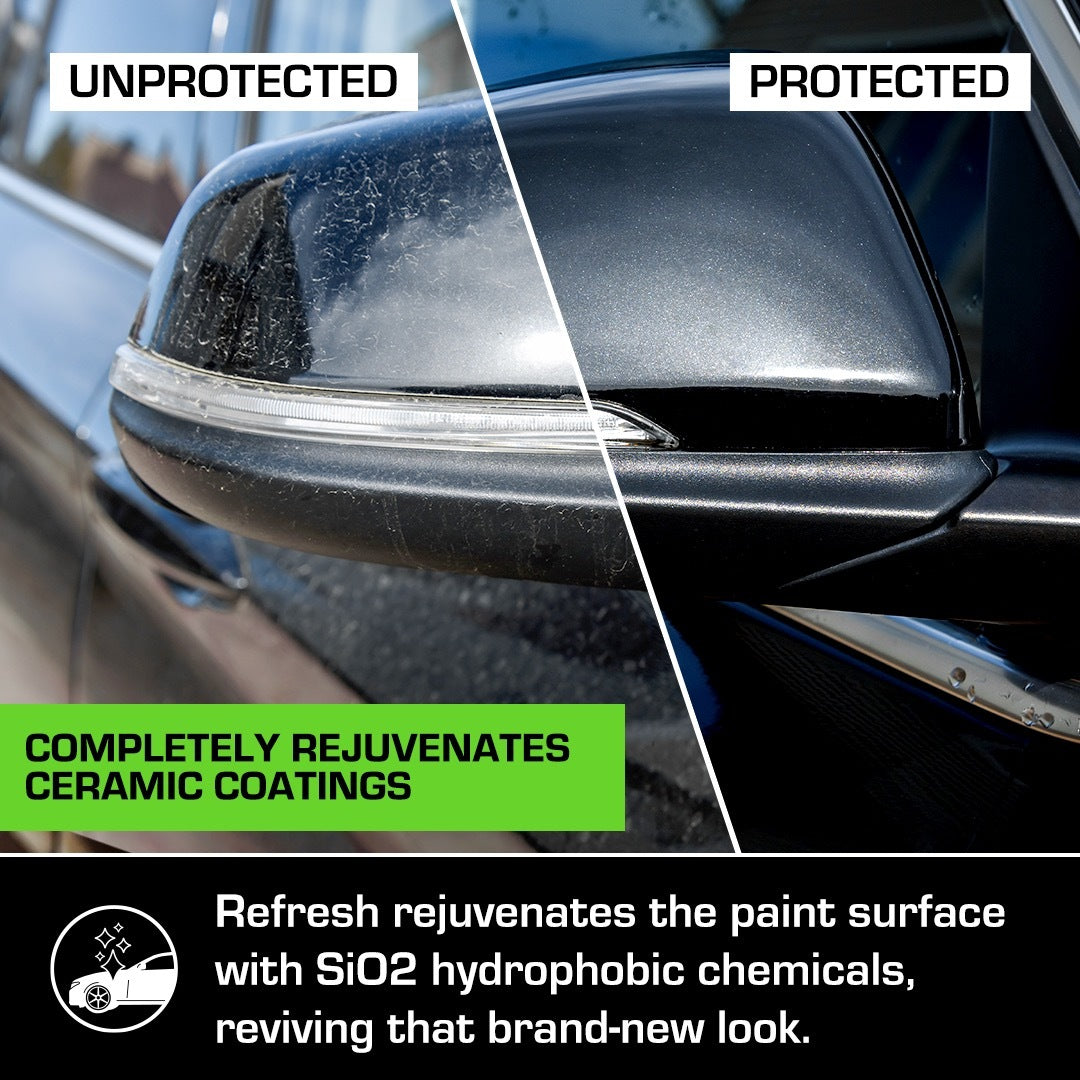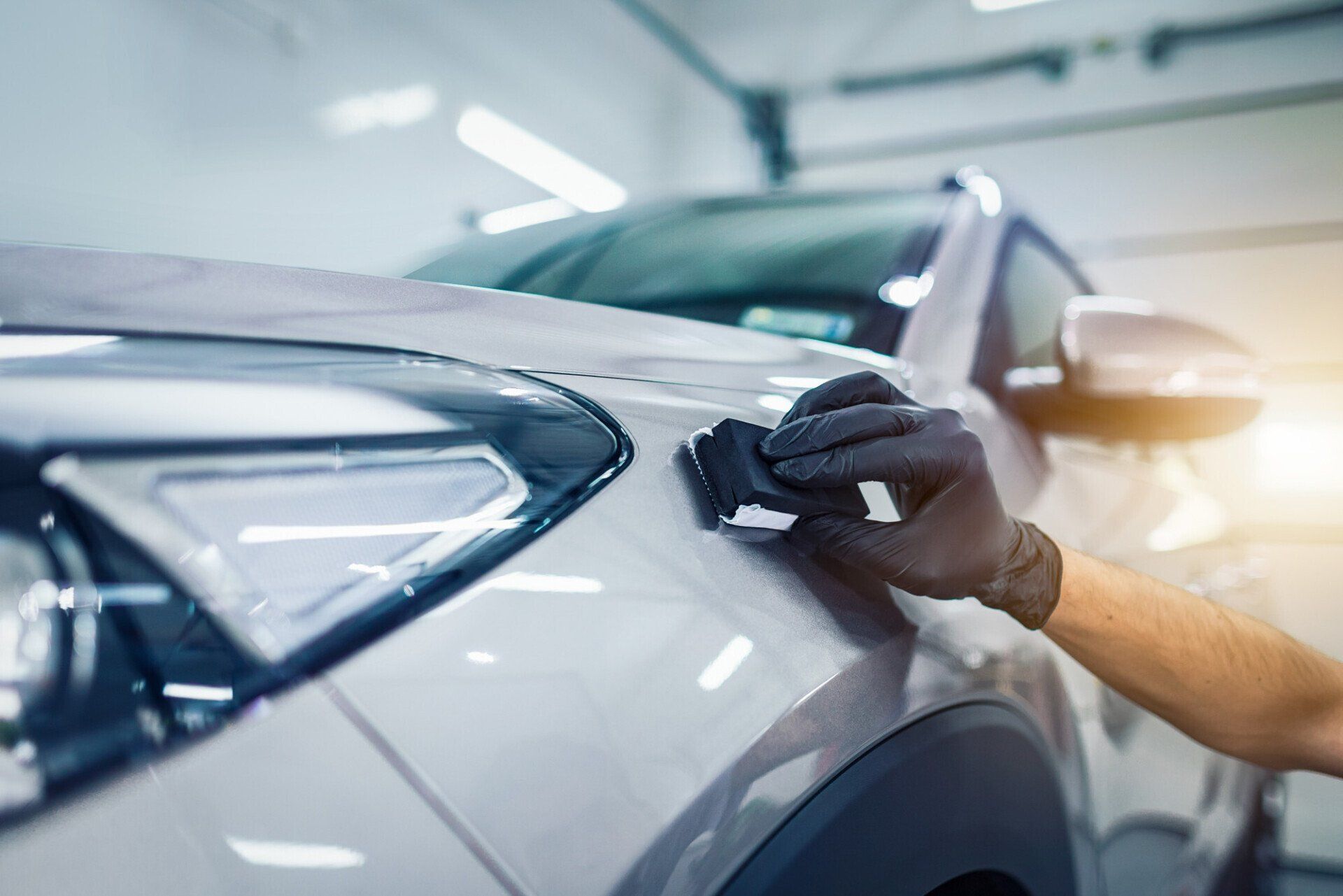Exploring the Scientific Research Behind Car Ceramic Coating and Its Safety Features
The scientific research of car ceramic coating presents an interesting study in sophisticated auto security. Made up mainly of silicon dioxide and polymers, these coatings develop a robust bond with car paint. This communication improves toughness versus ecological threats while offering hydrophobic advantages. However, the details of exactly how these coatings job and their long-term benefits stay less recognized. Unloading these details exposes why ceramic finishes are coming to be a recommended selection for automobile treatment
What Is Ceramic Coating?
Ceramic coating is a fluid polymer that chemically bonds to the surface area of an automobile's paint. This advanced safety layer enhances sturdiness and provides exceptional resistance to environmental factors. Unlike conventional wax or sealants, which supply momentary defense, ceramic coatings develop a lasting shield that can withstand extreme conditions such as UV rays, acidic impurities, and extreme climate. When applied correctly, the coating develops a hydrophobic surface area, triggering water to bead and slide off, which helps in keeping the lorry's cleanliness. Furthermore, it offers boosted gloss and deepness to the paint, making the vehicle appear more sleek and vibrant. The application procedure normally includes thorough surface preparation, consisting of cleaning and polishing, to assure peak bonding. Because of this, ceramic layers are ending up being significantly popular amongst car fanatics and those looking for to protect their financial investments, promising to keep the car's aesthetic appeal while reducing the frequency of upkeep.
The Composition of Ceramic Coatings
The intricate formula of ceramic finishings largely includes silicon dioxide (SiO2), which is acquired from natural resources like quartz and sand. This vital component gives the foundation for the coating's resilience and safety high qualities. Along with SiO2, ceramic finishings often include numerous polymers and ingredients that improve adhesion, versatility, and resistance to ecological elements. These compounds work synergistically to create a durable barrier versus contaminants such as dust, chemicals, and UV rays.Furthermore, some solutions incorporate titanium dioxide (TiO2) or other nanomaterials, which can augment the coating's hydrophobic residential or commercial properties, leading to improved water repellency. The accurate structure can vary significantly among manufacturers, impacting performance and longevity. Eventually, the mix of these aspects culminates in a safety layer that not only boosts the aesthetic appeal of lorries yet additionally serves to prolong their life-span by protecting the surface from potential damages.
Just How Ceramic Coatings Job
Comprehending just how ceramic layers function involves discovering their chemical structure, which adds to their protective top qualities. The application procedure is crucial for attaining ideal outcomes, while long life and toughness variables figure out the coating's effectiveness over time. With each other, these aspects highlight the benefits and efficiency of ceramic layers for vehicle protection.
Chemical Make-up Explained
While lots of car proprietors seek lasting security for their vehicles, the chemical composition of ceramic finishes plays an important duty in their effectiveness. These finishes mainly consist of silicon dioxide (SiO2), which is stemmed from all-natural minerals. This compound creates a strong bond with the car's paint, creating a long lasting, safety layer. In addition, numerous ceramic finishes contain titanium dioxide (TiO2), boosting their hydrophobic residential or commercial properties and resistance to UV rays. The presence of polysiloxanes can additionally boost flexibility and toughness. Together, these elements add to the coating's ability to fend off water, dust, and contaminants, while likewise providing a high-gloss finish. Understanding this chemical foundation aids car proprietors appreciate the robust security offered by ceramic finishings.
Application Refine Overview
Applying ceramic layers entails a careful procedure that ensures suitable bonding and security for the automobile's surface area. Originally, extensive cleansing and decontamination of the car's exterior are performed to eliminate dirt, grime, and previous waxes. This action verifies that the surface area is complimentary from impurities that could prevent attachment. Following this, the paint is typically polished to boost clarity and get rid of any type of imperfections. When prepared, the ceramic coating is used in tiny sections making use of an applicator pad, enabling consistent coverage. The coating is then entrusted to heal, creating a solid chemical bond with the surface area. Correct treating times and problems are critical, as they validate the coating achieves its maximum efficiency and safety high qualities.
Durability and Toughness Factors
Ceramic finishings are developed to offer long-lasting defense with their advanced chemical structure, which develops a durable barrier versus ecological impurities. The sturdiness of these finishes is affected by factors such as the density of the application, the quality of the product, and the problems under which the automobile is subjected. High-quality ceramic coverings can last numerous years, standing up to scratches, UV rays, and chemical stains. Correct maintenance, consisting of routine cleaning and regular reapplication, can additionally boost longevity. Additionally, environmental aspects like environment and exposure to toxins can impact the life-span of the coating. Generally, when used and preserved appropriately, ceramic finishes provide remarkable longevity, making them a prominent selection for car enthusiasts looking for to preserve their automobile's appearance.
Hydrophobic Properties and Water Repellency
Hydrophobic residential properties are a trademark of quality car ceramic layers, considerably boosting the car's surface performance. These finishings develop a molecular bond with the car's paint, leading to a surface area that wards off water properly. When water enters contact with a ceramic-coated surface area, it beads up and rolls off, lessening the amount of liquid that stays on the paint. This habits not only adds to a visually pleasing look yet likewise reduces the accumulation of contaminants such as dust, crud, and road salts.The improved water repellency brings about simpler cleansing and maintenance, as less effort is required to eliminate unwanted compounds. Additionally, the hydrophobic nature of ceramic layers assists in protecting against water places, which can mar the surface of uncoated surfaces. Overall, the consolidation of hydrophobic buildings in ceramic layers plays an important function in preserving the lorry's pristine appearance while simplifying upkeep.
Defense Versus Scratches and UV Damages
Car ceramic coverings provide significant protection against scratches and UV damage. The scrape resistance device develops a long lasting layer that takes in effects, while the get more UV shielding benefits aid preserve the vehicle's paint honesty with time. With each other, these functions add to a longer-lasting and aesthetically attractive finish.
Damage Resistance System
Using advanced modern technology, ceramic coatings supply a robust guard against scrapes and UV damages, improving the long life and look of car surfaces. The scrape resistance device of these layers is credited to their unique molecular framework, which develops a long lasting bond with the lorry's paint. This bond develops a hard, safety layer that can soak up influences and withstand abrasions. Furthermore, the smooth surface area of the coating minimizes friction, making it tough for impurities to stick and trigger scratches. The chemical structure of ceramic finishings typically includes nanoparticles that enhance the safety layer, further boosting its resilience. Lorries treated with ceramic finishings show considerably improved scratch resistance compared to typical wax or sealants, guaranteeing an excellent surface over time.
UV Shielding Perks
The safety qualities of ceramic coatings prolong beyond scrape resistance to include substantial UV protecting advantages. These finishings create a durable barrier that shows harmful ultraviolet rays, guarding the automobile's paint and underlying materials. Extended direct exposure to UV radiation can cause fading, oxidation, and deterioration of the paint coating. By including ceramic finishings, vehicle proprietors can efficiently alleviate these risks, protecting the aesthetic charm and integrity of their autos. Additionally, the UV obstructing residential properties add to improved longevity, reducing the regularity of repainting and upkeep. Eventually, the assimilation of ceramic finishes provides a thorough service for shielding cars from the harmful impacts of sun direct exposure, ensuring a continual, lively appearance with time.
The Durability and Upkeep of Ceramic Coatings

Regularly Asked Concerns
Can Porcelain Coating Be Applied to Any Type Of Kind Of Lorry?
Ceramic coating can be put on numerous kinds of lorries, including automobiles, trucks, and bikes. Surface prep work and compatibility with details products are crucial for excellent attachment and efficiency of the coating.
Just How Much Does Ceramic Coating Typically Expense?
Ceramic coating usually costs between $500 and $2,000, depending on factors such as vehicle dimension, coating top quality, and specialist application. The financial investment can give durable defense and improve the automobile's appearance in time.

Is Expert Application Essential for Best Results?
The requirement of specialist application often depends on wanted outcomes. Specialists generally ensure appropriate surface area prep work and application strategies, resulting in perfect bonding and long life of the coating, which might be testing for inexperienced individuals to attain.
Can Porcelain Coatings Be Eliminated or Repaired?
Ceramic coatings can be gotten rid of or fixed, though the procedure may require specific solvents or methods - Ceramic Coating Newark. Appropriate elimination is important to stay clear of damages to the underlying surface, emphasizing the value of specialist assistance for perfect results
Exactly How Does Ceramic Coating Contrast to Standard Wax?
The comparison between ceramic coating and traditional wax reveals that ceramic coatings offer premium longevity, improved Look At This defense against environmental impurities, and longer-lasting luster, while wax requires extra regular application and offers much less overall resistance to damages.